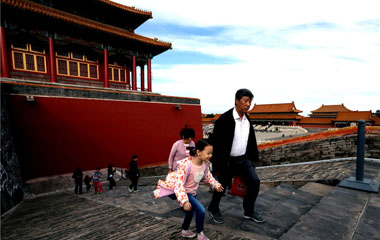Pigs of paradise
Updated: 2015-10-13 08:44
By Xu Junqian(China Daily)
|
|||||||||
Famed 'fragrant' pork, a Tibetan-style delicacy, delivers an authentic taste of Shangri-La, Xu Junqian discovers at a high-altitude tasting.
The rarefied air on the Shangri-La plateau - with an altitude of 3,270 meters in southern China's Yunnan province - isn't really the reason that chef Wu Tinggang speaks slowly with deliberate pauses. Neither isn't the silky smooth cabernet sauvignon produced from the highest vineyard in the world, Shangri-La Vineyard, though Wu sips more than half a dozen of glasses throughout the evening.
During his almost-20-year culinary career, the 37-year-old has cooked scores of steaks per day as part of training back at school, and catered for a luxury cruise with 5,000 passengers and 2,000 crew members for eight months. Now, however, in his new role as executive chef at Hylandia by Shangri-La, Wu simply finds it "an obligation" to slow down, enjoy work and life, and be idle, if not downright lazy.
"I was told on my first day here that if one doesn't have altitude sickness during the first month, it's Shangri-La wanting him to stay and enjoy the life here. Here I am, three months later with some altitude weight gain even," he jokes. The native of Chengdu, Sichuan province, had never in his life been to a plateau before coming to Shangri-La in June.
Three months later, the big achievement from Wu's kitchen, with some 20 cooks and another 20 helpers, is the smoky black Tibetan pork rib that, at a first glance, is no match for its classic Chinese peers, such as the golden-crusted and deep-fried pork chop from Shanghai, or the translucent half-fat-half-lean red-braised pork cube from Hunan province.
Launched in August, Hylandia by Shangri-La is deemed an important milestone for the Hong-Kong hospitality group, as Shangri-La, the city, is popularly believed to be the physical inspiration of the earthly paradise depicted by James Hilton in Lost Horizon, from which the hotel group takes its name.
While it has taken the group seven years of effort to build a hotel for modern-day explorers to "discover their own slices of paradise", chef Wu says his own job-to offer a bite of heavenly cuisine-has just begun.
He begins from pigs, or more precisely, Tibetan fragrant pigs.
A Tibetan fragrant pig, as the locals define it, has fed on wild nuts and snow-melt water. Trim from trotting around every day at an altitude up to 4,000 meters, it should be no heavier than 75 kilograms. It is believed to be an accidental hybrid from male wild boars in the primeval forests and female domestic pigs tended long ago by hunger-stricken Tibetans, who attempted to catch wild boars to fancy up their meals by having their female farm animals seduce them.
The pig doesn't really give off a more pleasant smell than its flatland folks-not when alive.
"Many people shun pork because of the greasy and guilty fatness, but the Tibetan pig has the perfect proportion of fat and lean meat for roasting," says Wu.
He discovered the meat during a lunch with a Tibetan family while doing his field research about local cuisine.
Hidden in northwest Yunnan's Diqing Tibetan autonomous prefecture, Shangri-La enjoys a unique geographical location that borders Sichuan, Tibet and Yunnan. As a result, the local cuisine is known for its combination of flavors from the three areas.
For example, Wu's Tibetan pigs are marinated in 18 different Sichuan spices and herbs for five hours, and then roasted on charcoal made of three types of wood from Yunnan, the most forested province in China.
"Always judge a pig by its fat," Wu says he tells his cooks and chefs. "A qualified chef (for cooking Tibetan dishes) must be able to tell the difference between a Tibetan pig and a common one, which lies in the fat they carry."
A more apt comparison for the roast Tibetan pig would be to cochinillo asado, or Spanish roast suckling pig. Although the Tibetan one doesn't look like cochinillo upon serving - the meat is much darker in color and wrapped in lettuce leaves-the texture of the pork is similarly moist and chewy. The only difference is that there is a more exotic and aromatic flavor thanks to spices, herbs and the smoke from pine, peach and plum charcoal.
The classic accompaniments are roasted potatoes and ears of corn, and the hotel's suggested wine, cabernet sauvignon also from Shangri-La, makes an excellent pairing. But the best "sauce" spicing up the experience is the atmosphere. The pig is roasted a la minute in open air, 5 kilometers away from the hotel, under a wood stand that locals use for drying green barley, deep in a valley surrounded by snow-capped mountains and deep gorges. It's apart of a day trip, if not the highlight, that the hotel offers to organize for guests who want to experience local villages and the culture.
"This is my slice of Shangri-La," says Wu, who is also working on interpretations of yakmilk yoghurt and matsutake sashimi, which are already served at the hotel, but are not yet "perfect".
"Come to Shangri-La, if you are out of work. Come to Shangri-La, if you are out of love," Wu mumbles.
"Were you out of work or love?" I ask.
"I am now in love with Tibetan pigs and employed at the world's most beautiful place," he says.
Contact the writer at xujunqian@chinadaily.com.cn
(China Daily 10/13/2015 page19)
- Air pollution dominates complaints to environmental ministry
- WHO calls for stricter curbs on tobacco promotion in China
- Pilot risks own life to save others after plane's engine fails
- Palace Museum's western part opens for first time in 90 years
- Suspect of fishing boat murder caught in E China
- 'Queen of Ivory' faces charge in Tanzania

 Musical selfie
Musical selfie
 Chinese spending spree drives Japanese economy
Chinese spending spree drives Japanese economy
 Chasing time: Man amasses large watch collection
Chasing time: Man amasses large watch collection
 Palace Museum's western part opens for first time in 90 years
Palace Museum's western part opens for first time in 90 years
 Vivid sand sculptures attract visitors in Hunan
Vivid sand sculptures attract visitors in Hunan
 One killed in Northern Arizona University shooting
One killed in Northern Arizona University shooting
 Students join outdoor courses in countryside
Students join outdoor courses in countryside
 Stewardesses trained to show sweet smile
Stewardesses trained to show sweet smile
Most Viewed
Editor's Picks

|

|

|

|

|

|
Today's Top News
Tu first Chinese to win Nobel Prize in Medicine
Huntsman says Sino-US relationship needs common goals
Xi pledges $2 billion to help developing countries
Young people from US look forward to Xi's state visit: Survey
US to accept more refugees than planned
Li calls on State-owned firms to tap more global markets
Apple's iOS App Store suffers first major attack
Japan enacts new security laws to overturn postwar pacifism
US Weekly

|

|








